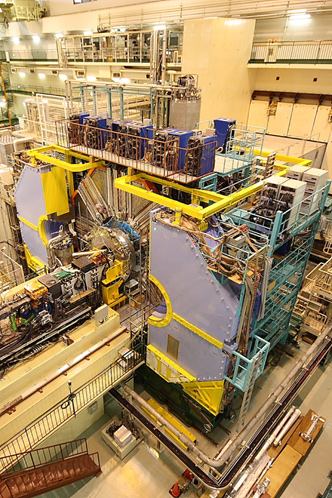The BELLE Experiment

The BELLE experiment was built primarily to study the CP violation in B meson system. The e+e– collider machine was tuned at Y(4S) resonance that falls into a dominant decay channel of B meson pair production. In order to obtain a firm evidence of the tiny CP violation, the BELLE experiment had been running with the world highest luminosity for nearly 10 years, accumulating an enormous statistics of high quality data. In 2003 the so-called X(3872) state was discovered in the BELLE data. This exotic hadron, reminded us that the constituent quark model does not prohibit the existence of hadrons with four quarks, besides the firmly established baryon and meson. This discovery has created a whole new field and the BELLE data turned out to be a treasure island for hadron physicist.
SMI has joined the BELLE collaboration in 2011 to analyze the data for the following two major interests.
One focus is related to the PANDA experiment. Although distinct in their primary conceptions and goals, BELLE and PANDA cover common physics topics. The energy range of the antiproton beams at PANDA will be up to 5.5 GeV/c² in the NN c.m. frame, thus covering the region of hadrons containing the charm quark. Indeed, precision spectroscopy of charmonia and the study of open charm is one of the key issues of the PANDA physics program. The BBbar as well as the 'continuum' events at KEK-BELLE provide a rich opportunity to perform these types of analyses. In fact a big fraction of the more recent publications in the sector of hadron physics with charm comes from B-factories, like KEK-BELLE. Thus analysis activities on BELLE data are very interesting by themselves but in addition an excellent chance to gain more experience in hadron spectroscopy analysis techniques, from which we will profit later on with PANDA.
According to these ideas we recently started to search in BELLE data for the existence of the charmonium state ηc2. This state has a predicted mass of 3750 - 3850 MeV/c², thus lies slightly above the DDbar threshold and was not observed yet, neither with BELLE nor with other experiments. ηc2 is predicted to decay by emission of two gammas to hc and further to ηc. The search is performed with an invariant mass analysis (reconstruction of the four-momentum of ηc2 from the measured four-momenta of the daughter particles). This analysis shall be finished within this year.
The other focus is related to the existing activity of the institute on strangeness nuclear/hadron physics, and we extend it to the charmed sector. The search for kaonic nuclei is one of the major themes in hadron physics since its possible existence was predicted. The KN interaction is the fundamental theoretical input to the study of few-body systems with antikaons. The scattering lengths of the πΣ systems are key quantities in understanding the subthreshold behaviour of the KN interaction and the structure of the Λ(1405) resonance which is a quasi-bound KN state embedded in the πΣ continuum, and hence are essential to understand the kaonic nuclei. The πΣ scattering lengths can be extracted from the threshold cusp phenomena in the weak Λc→ππΣ decays, in analogy with Cabibbo’s method for determination of the ππ scattering length. Such kind of study is feasible at BELLE where a huge amount of Λc is produced through the B-meson decay.